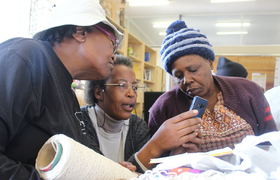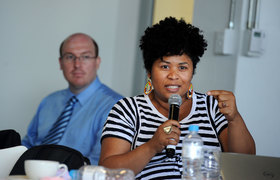COVID-19 could ‘derail’ gender-equality progress in SA’s labour market
17 November 2020 | Story Niémah Davids. Photo Adobe Stock. Voice Neliswa Sosibo. Read time 6 min.
Decades of work and hard-won gains into achieving gender equality in the labour market in South Africa could be derailed by the effects of the COVID-19 pandemic.
This is according to a research paper by the Southern African Labour and Development Research Unit (SALDRU) at the University of Cape Town (UCT). Lead author Dr Jacqueline Mosomi said that the paper, “Unpacking the potential implications of COVID-19 for gender inequality in the SA labour market”, studied the industries adversely affected by the pandemic – and in turn, what this means for gender equality in the labour market.
Since the onset of democracy, Dr Mosomi said, women have made significant progress in the labour market. Research indicates that the gender wage gap improved from 40% in 1994 to 16% in 2014. But as a result of the COVID-19 pandemic and the nationwide lockdown, these gains hang in the balance.
“Because of the nature of the occupations women are in, they are at a higher risk of losing their source of income.”
“Because of the nature of the occupations women are in, they are at a higher risk of losing their source of income. They are also more likely to be exposed to the virus when compared [with] men,” Mosomi said.
Affected industries
According to Mosomi, in the past, global financial crises have unintentionally reduced gender inequality in the labour market – only because they have impacted male-dominated industries more than industries dominated by women. However, the health risks associated with the COVID-19 pandemic set it apart from past economic downturns.
She noted that the pandemic and lockdown have directly affected some of the largest employment industries for women in the country. Four key sectors which employ mainly women have been hardest hit. These include the services sector, which employs approximately 31% of all employed women; followed by the trade, finance and domestic worker sectors, which employ 22%, 15% and 14% of women respectively.
“One concern is that the COVID-19 pandemic may undermine access to income for women – and black women, in particular – more so than for men. This is because female employment is clustered in the services sector, adversely affected by the health and safety protocols implemented to reduce infection,” she said.
This could be a major setback for gender equality in the labour market, she added.
Unpacking the findings
Mosomi said that because Level 5 of the nationwide lockdown required a complete shutdown of services, with the exception of essential workers, more women experienced loss of income, compared with men.
The research indicated that 66.48% of employed women were not classified as essential services staff, compared with 59.05% of employed men. And because of the nature of their jobs, these women could not work from home, resulting in a loss of income.
“[Many of] the essential services categories – like mining, construction, plant machine operators and protective services – are male-dominated industries.”
“This is largely because [many of] the essential services categories – like mining, construction, plant machine operators and protective services – are male-dominated industries,” she said.
On the other hand, the study revealed that other occupations dominated by women are reported to leave women 16% more at risk of contracting infectious diseases, such as COVID-19. Roughly 23% of the jobs occupied by women are directly exposed to infectious disease, compared with 7% of the jobs occupied by men.
The data demonstrates that aside from making up most of the domestic workers and primary school teachers in the country, women also make up 78% of personal care workers, 92% of home-based care workers, 57% of doctors, 87% of nurses, 76% of medical assistants and 47% of pharmacists.
“The implications here for women who continued to work throughout the hard lockdown because they were classified as essential services staff, [is that] they were – and still are – more exposed to the virus,” Mosomi said.
Job losses
Previous research by the National Income Dynamics Study – Coronavirus Rapid Mobile Survey (NIDS-CRAM) indicated that a whopping 67% of the jobs lost during lockdown Level 5 were occupied by women. According to Statistics South Africa, in the first two quarters of 2020 the services sector shed 515 000 jobs, followed by the trade sector (373 000), the domestic worker sector (311 000), the finance sector (283 000), the construction sector (278 000) and the manufacturing sector (250 000).
“Of great concern is that even with the easing of lockdown restrictions under Level 3 of lockdown, employment numbers didn’t improve significantly.”
“These sectors are dominated by women. Of great concern is that even with the easing of lockdown restrictions under Level 3 of lockdown, employment numbers didn’t improve significantly,” Mosomi added.
“With this as a reality, a major concern for us is that the progress that has been made towards reducing gender inequality in the labour market over the last 20 years will be held back. We need to work very hard to turn the tanker around.”
Researchers have committed to keeping a close eye on this area, and will track any progress or regress made.
 This work is licensed under a Creative Commons Attribution-NoDerivatives 4.0 International License.
This work is licensed under a Creative Commons Attribution-NoDerivatives 4.0 International License.
Please view the republishing articles page for more information.










